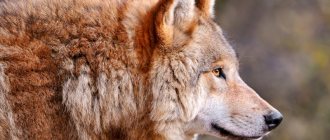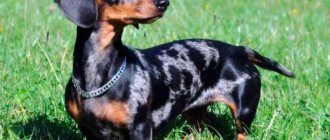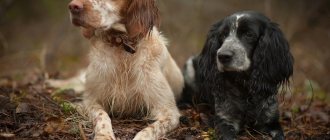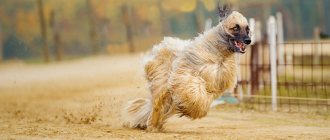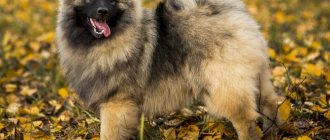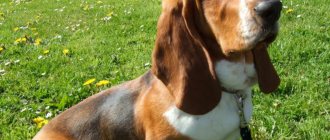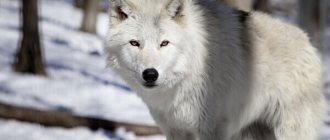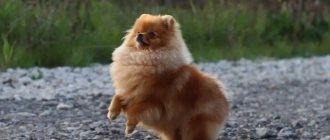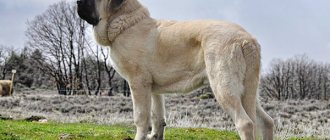A wolf hybrid is an exotic pet that not every dog owner can handle. A serious animal, with wild blood and an equally uncontrollable disposition, is not recommended for home breeding in many countries. In America, hybrids are considered wild animals. And in Russia, this breed is included in the “List of Potentially Dangerous Dog Breeds,” for which the law imposes special breeding and maintenance requirements.
Let's take a closer look at the hybrid of a wolf and a dog in order to clearly understand who we are dealing with - a domestic animal or a wild animal. Let's talk about the characteristics of the hybrid breed, the types of wolf-dogs, the features of their maintenance and upbringing. We hope that this information will help you assess your strengths and understand whether such a pet is right for you.
What is a wolf hybrid
Dogs evolved from wolves over many millennia. But these two species are related and are interfertile. This means that when these two species are crossed, viable offspring are obtained that are subsequently capable of reproduction. A dog crossed with a wolf is called a wolf dog or wolf hybrid.
A similar crossing occurs when two related species of animals are mated by chance or by plan: a wolf and a dog. Accidental mating is possible in the wild, when feral stray dogs mate with wolves. This happens, but not too often. Most often, a pair of dog and wolf is the result of the activities of breeders who cross these two species for the purpose of further sale.
Hybrids also include the offspring of a wolf and a wolf-dog, puppies born from two wolf-dogs.
Why do wolves and dogs mate in the wild?
Mixed breeding between a wolf and a dog in the wild is the result of mating between a male wild wolf and a female domestic dog. Such hybrids occur naturally, but are quite rare. This is because wolves have a highly developed sense of territoriality. They protect their property from encroachment by other species: feral dogs, coyotes.
Gray wolves most often interbreed with large domestic dogs - they are genetically closer to dogs than other wolf species. When does this mixing of species occur? If the wolf population declines sharply for some reason (1 individual per thousand km2), males are forced to look for a mate among other related species. This situation is possible if there is intensive shooting of wolves.
The second reason for the appearance of half-wolves in the wild is the encroachment of people into territories that historically belonged to wolves. That is, if wolves and domestic dogs live in close proximity, their crossing can produce wolf-dog hybrids.
Why are dog-wolf hybrids popular?
In some countries, a fashion has emerged for hybrid breeds. People willingly share photos of their massive semi-wild pets on social networks. To ordinary people, far from biology and genetics, it seems that you can have a pet that will look like a wild wolf and behave like a dog. This opinion is a mistake. A wolfdog is not a dog! A half-breed will never behave like a real house dog. Wild roots will always remind you of themselves. Keeping such a pet is difficult and not always safe; not everyone is up to the task.
Some people love the idea that they can tame a beautiful wild animal, tame it and bend it to their will. Hybrids are indeed very powerful and beautiful animals. They are strong and determined. But you shouldn’t get a pet just to touch the legendary semi-mythical image of a wolf. Such a decision must be balanced and responsible.
The irresponsibility of some owners leads to very sad consequences. People take half-bred puppies, and when they grow up and become wayward and difficult to manage, they are abandoned or euthanized. It’s good if the animal goes to a shelter where it will be taken care of. But not everyone is so lucky. In addition, a mixture of a wolf and a dog is an explosive mixture. Hybrids can be unpredictable and dangerous both for their owners and for others.
Mestizos Laikas
Breeding half-breed dogs is not always beneficial; some breeders can be 100% sure that they have acquired a purebred puppy, but in the end, after the first litter, it turns out that this is not at all the case. Leading breeders and dog handlers have repeatedly spoken out against unauthorized and unqualified crossing of different species.
Photo of Laika and Husky
An overly active character and selfishness, as a rule, are extinguished by the devotion and calmness of the husky. A cross between a husky and a husky would be an ideal option for a family with small children. The hunting instinct is perfectly extinguished by responsiveness and kindness thanks to a cross between several breeds. You should also remember that this species is more prone to low temperatures, and if you are going to get yourself a husky, you will have to provide suitable conditions for keeping it. An excellent option in a private home would be to have a canopy or net that will create shade and the pet will be able to hide from the heat. His bowl should always contain clean and cool water - especially in the summer.
Mixed Husky
The history of the appearance of the wolfdog breed
The first mention of the crossing of dogs and wolves dates back to the middle of the 18th century. However, the deliberate practice of breeding wolfdogs began on Colorado farms in the 1950s. Then a group of enthusiasts, concerned about the decline in the wild wolf population, began crossing them with domestic dogs in order to somehow stop this process. Breeders crossed gray, red and Ethiopian wolves with large dogs: German shepherd, Siberian husky, Alaskan malamute.
Modern hybrids are not the first offspring of a wild wolf and a domestic dog. This is the result of crossing several generations of hybrid breeds with each other. Most purebred wolfdogs can trace their history back to those Colorado dog farms of the 1950s.
Alaskan Malamute
As the name suggests, this dog breed originated in Alaska. The animals are designed to work in harness, are hardy, strong, smart and good-natured. Despite its impressive appearance, aggression towards people is not typical for the breed, but raising the dog must be done seriously and consistently. He does not fight for leadership with a person and is friendly towards new family members, including children.
The Malamute strives for leadership and quickly becomes the head of a group of dogs. But he is friendly towards small animals, including cats.
Like any working dog, the Malamute needs daily exercise. If the dog is kept outdoors, it is worth considering that Malamutes are big fans of digging holes. They rarely bark, but often make grumbling sounds.
Wolf-dog hybrids - what breeds are there?
There are many options for wolf mixes. They all differ in appearance and have distinctive features. Each one is unique in its own way. Depending on what type of wolf and what breed of dog is taken for crossing, the characteristics of the hybrid will depend.
Wolf-dog hybrids, wolf-dogs and wolf hybrids - breeds
We were not mistaken in highlighting these three names. Indeed, in some canine standards these three concepts are not mixed. But let’s not delve into the standards; each country has its own standards; let’s list the most popular existing hybrid species.
- The Alaskan Malamute hybrid (Wolamut) is a mixture of the gray wolf and the Alaskan Malamute. The breed was bred in the USA, but is not recognized by the FCI.
- Alabai crossed with a wolf. Wolf independence, anthropophobia (fear of people), bestialism (hunting poultry and livestock) neutralize all the positive breed characteristics of the Alabai.
- The Kunming Wolf Dog is a German Shepherd crossed with a wolf. To create the breed, wolf species living in China were taken. The breed was bred and recognized in China. The FCI does not recognize the breed. Dogs are used in patrol and search work.
- The Saarloos Wolfdog is a cross between a Canadian wolf and a German shepherd. The breed is recognized by the FCI.
- The Czechoslovakian Wolfdog is a cross between the Carpathian wolf and the German Shepherd. Recognized by the International Film Festival.
- The Italian wolf (Lupo Italiano) is a wolf crossed with a German shepherd. In Italy the breed is protected and its breeding is controlled. The FCI does not recognize the breed.
- Husky Wolf Mix is a hybrid of a Siberian husky and a wolf.
- The Russian Wolfhund is a black wolfdog, the largest of their hybrids.
- A mixture of a wolf and a husky is a species of so-called wolf-dogs, which are not recognized by canine associations. Work on a hybrid of the West Siberian husky and a wolf was actively carried out at the end of the 20th century in the USSR.
Important: serious breeding work to improve the breed qualities of dogs has been carried out by scientists from different countries since 1970 of the 20th century, but all of them did not lead to the desired result. A wolf-dog hybrid acceptable for safe home keeping has never been bred.
German Shepherd
Everyone is well aware of the unsurpassed qualities of the German Shepherd; they have rightfully earned primacy among service breeds. Easy learning and unsurpassed intelligence make it possible to use them in a wide variety of areas of human life. In addition, shepherd dogs also get along well as companion dogs; they are not aggressive and get along well with children. Purebred German Shepherds win many medals at international dog shows.
Shepsky is a cross between a German Shepherd and a Husky.
The shepherd-husky mix gives rise to a new species called the Shepsky. These half-breeds will be excellent guards for your home. But everywhere has its downsides, and it is a sense of proportion regarding their property that can reveal the most negative character traits. A German Shepherd and a Husky provide you with a reliable and loyal guard, but you shouldn't leave a Shepsky, for example, alone with newly arrived guests or with a loud crowd of children. Having accepted any actions in their direction as a threat, the Shepski will not hesitate and will immediately attack the stranger. During meals, these half-breeds are also very irritable. Half-breeds from a shepherd are best used for official purposes.
Description of the dog breed: wolf-dogs
Although each hybrid breed's conformation is unique, all wolfdogs have common traits. These are powerful, harmoniously built animals, resembling wild wolves in appearance. The “wildness” of half-wolves is noted in their movements, posture, gaze, grin and coat color.
These are strong animals with excellent health. They do not have many of the genetic pathologies that are observed in dogs that became the progenitors of the hybrid. Behind this “beauty of a wild beast,” which involuntarily attracts the eye, hides “animal habits.”
Characteristics of the wolfdog breed
The bestial appearance of half-breed wolves is not the only thing that hybrids have left from their forest parents. Mestizos absorbed the character of both wolves and dogs. But at the same time, due to the unnatural crossing of a wild predator and a completely domesticated dog, some characteristics were enhanced, while others were completely lost.
The more wolf blood flows in the veins of a hybrid, the wilder its temperament will be. This point should always be taken into account when deciding on choosing such a pet. The “animality” of the temperament also depends on how many generations separate your dog from the first wild ancestors.
Wolves mature much later than domestic dogs, so their full temperament is revealed at the time of puberty at 18 months. Half-breeds can show affection towards their family members, children and pets. But they still have wild instincts of predators, so it is unacceptable to leave children and pets alone with half-wolves.
From forest parents, hybrids inherited fear of man (anthropophobia), bestialism (hunting for livestock) and the habit of marking territory with their feces. It is unlikely that anyone would like such qualities of a pet.
In addition, a cross between a wolf and a dog can show strong aggression towards both strangers and members of its own family. So they try to win a higher hierarchical position from a person. Cases of wolf mestizos attacking humans are not uncommon. This undesirable characteristic is the most common reason pets are abandoned and brought to animal shelters.
Wolfdog of Saarloos
Czechoslovakian Wolfdog
How does a wolfdog puppy differ from dog puppies?
Until wolfdog puppies have reached sexual maturity, they can be mistaken for the offspring of an ordinary domestic dog. The striking features of hybrids appear after age-related changes in the hormonal background of the animal. However, even the smallest half-breed wolf cubs are different from dog cubs.
How can you understand that this is a half-breed puppy:
- Offspring develop unpredictably. The main developmental stages of dogs and wolves occur at different times. The rate of development of puppies is difficult to predict.
- Early interaction of hybrid offspring with humans is difficult. It takes much longer for puppies to get used to people and stop being afraid of them.
- Hybrid puppies received fear of new sounds and visual stimuli from wolves. They are afraid when they first begin to see and hear. Dog offspring do not have such sensory shocks.
Italian wolf (lupo italiano)
Siberian Husky
What is the most popular wolf dog today? The Siberian Husky breed is currently widespread. These dogs are not aggressive towards people and cannot be used as guards. They do not quarrel with other dogs of large breeds, but in relation to small animals - cats, rabbits, small dogs - the hunting instinct can work. Huskies are active and friendly, but independent, which makes them unsuitable for service. Sled dogs can be trained to obey, but don't expect the same success as German Shepherds.
Husky is suitable for keeping in an apartment provided that it receives constant physical and mental stress. It is difficult to keep them in a fenced area, because dogs have a tendency to run away, and the hunter's instinct makes them dangerous for neighboring animals. They jump over fences and make tunnels.
Huskies have a strong pack instinct, so it is advisable to keep them in a group. These dogs do not bark, but whine and howl like wolves. The color can be very different; individuals with eyes of different colors are often found.
How to properly deal with half-wolves
To keep an exotic half-breed pet, you will need to create special conditions and learn how to handle them. Without certain knowledge of the physiology and psychology of mixed breeds, this venture may turn out to be a failure at best. And at worst, lead to serious irreparable consequences for both the pet and its owner.
These types are not suitable for home apartment maintenance. Throw away the idea of getting a wolf hybrid if you only have a city apartment to spare.
For content you will need:
- Lots of space away from other people and noisy highways. A farm somewhere in the forest is an ideal place to keep this breed. The following habits were passed on to the hybrids from wolves: howling loudly and constantly wandering. They need the presence of wildlife to explore. There they will not disturb their neighbors with their howling, and the noise from cars will not frighten the pets.
- The space in which wolves are kept must be at least 0.2 hectares per individual. This should be a securely fenced area with a high fence (2.5 meters) so that the animal cannot jump over it. And a deep concrete foundation so that the pet cannot dig under it.
- It is best to enclose the space for keeping hybrids with a double fence with teeth curved inward.
- It is necessary to ensure good soil drainage in the area so that animals can find dry areas in rainy weather.
- The booth is not suitable for keeping wolfdogs. It is necessary to build a spacious house with a high shelf so that the pet can occupy a position on a hill.
- Low-growing shrubs and trees should be planted on the site so that the animal finds shelter in the heat. It is unacceptable to plant tall trees near a fence - the pet may run away!
- The gates are installed high - 1.8-2 meters. Gate latches must be reliable.
Important: immediately evaluate your ability to create the right space for keeping wolf hybrids. If you are not ready to provide your pet with such conditions, give up the idea of getting a wolf-dog.
Are wolf-dog hybrids trainable?
Mixed breeds of wolves and dogs are naturally intelligent and quick-witted. But they are also stubborn, self-willed and very energetic. To keep your pet in good shape, you need 1 to 3 hours of physical activity per day. You need to walk them a lot and actively.
Let's look at the educational and training features of wolf-dog hybrid dog breeds.
- The offspring of wolves and dogs are more difficult to train. These puppies have stronger instincts and are ready to follow them.
- The person must immediately indicate to the pet that he is in the role of the alpha male. Weak owners will not be able to constantly maintain this position. The pet will always try to take a dominant position, expressing this through disobedience to the person, refusal to follow commands and demands.
- Half-breeds have a strong fear of new situations and people - this makes training difficult.
- Toilet training on the street causes certain difficulties. Wolves are accustomed to marking their territory with feces. When they defecate at home, it is a territorial instinct, not a protest.
- Wolf instincts and aggression can trigger at any moment. A pet can attack a child, another pet, livestock or bird.
Husky Wolf Mix – a hybrid of a Siberian husky and a wolf
How to feed breeds that are wolf-dog hybrids
Conventional dog food is not suitable for feeding hybrid breeds. The diet of such a dog should consist of fresh meat. The best options are wild game, elk, bison, beef, lamb, rabbit, chicken and turkey. Pork causes digestive problems and should be avoided.
The meat is given raw along with the bones. Bones are not a problem for wolf descendants. They do a great job with them. The descendants of wolves do not need cereals. Pets are given fruits, vegetables and fresh herbs as sources of vitamins and fiber. The area where the pet is kept must have grassy soil so that the animals can eat grass.
To compensate for the lack of vitamins and minerals, you need to give fortified supplements as prescribed by your veterinarian. Particular attention should be paid to access to fresh fresh water. It is best to organize a drinking trough on the site, similar to the kind they make for keeping livestock. During the hot season, it would be a good idea to place a children’s pool on the property so that your pet can drink and swim in it.
Health of wolf-dog hybrids
Crossbreeding species with different genetics has a positive effect on the health of the offspring. Puppies that result from mating between wolves and dogs are much stronger and healthier. They do not exhibit those breed genetic pathologies that are inherent in purebred dogs. This proven fact was the main reason why people wanted to crossbreed dogs with wild carnivores. But such crossing has its pros and cons.
Nutrition for mixed pets
Mixed-breed dogs require a rational, balanced diet, taking into account the nutritional value and calorie content of foods
It is especially important to feed puppies adequately, since the correct development of the skeletal and nervous systems is laid down in childhood. Lack of essential microelements can lead to rickets in your pet.
Note! The daily nutritional intake, taking into account the necessary vitamins, macro- and microelements, is difficult for a non-professional to calculate. The veterinarian will help you create a complete menu for your pet.
The diet of mixed breeds is compiled taking into account the dog’s weight, its metabolism and the characteristics of the parent breeds. The husky-shepherd mix has a fast metabolism, moves a lot and has a good appetite. She is fed natural food, which contains:
- cereals;
- dairy products;
- meat;
- cereals;
- vegetables;
- meat by-products;
- vitamin supplements and minerals.
A puppy needs dairy products for normal development.
It is also possible to include high-quality dry food in the diet, which contains a balanced daily intake of nutrients. Mixed-breed puppies are fed three to four times a day; an adult animal needs two meals a day.
Advantages and disadvantages
To make it easier for you to form your attitude towards this hybrid of a wild predatory animal and a domestic dog, we have summarized all the information and highlighted the main pros and cons of the hybrid breed of dog and wolf.
Pros:
- high intelligence;
- strong attachment to the owner;
- endurance;
- high performance characteristics;
- unpretentiousness in food;
- excellent health;
- unpretentiousness to conditions of detention.
Minuses:
- a pronounced desire for dominance;
- cause fear in other people;
- do not strive to please the owner;
- require large space for maintenance;
- require long hours of physical activity;
- they like to dig, they can spoil plantings and destroy flower beds;
- constantly mark the territory with their feces;
- hunt livestock and other pets;
- suffer from anthropophobia;
- behavior is inconsistent and difficult to predict;
- extremely curious, can damage things, furniture, communications.
Advantages of a crossbreed
If you are engaged in tourism and hunting, then the husky will be irreplaceable, but such a dog will not get along in a city apartment, since it needs to constantly move and do a certain job that it loves. Therefore, a cross between a shepherd and a husky will be the best option for city life.
The husky breed has an individual and secretive nature, so it may not adapt to life in a metropolis. But the shepherd dog unquestioningly obeys its owner and the usual fuss is acceptable to it. Therefore, the mestizo will be able to better adapt to such conditions.
Also, the crossbreed will feel most comfortable in a small area. After all, a shepherd dog only needs a few meters for its usual living, but a husky constantly needs a large space of several hundred meters.
If you buy a puppy that is the result of crossing a husky and a shepherd dog, you will be making a friend for life. After all, everyone knows the devotion of a shepherd dog, which can protect its territory and owner in any situation. And if you add to this the friendliness, calmness and playfulness of the husky, you will get a very good dog.
In any case, if you decide to get a mixed breed of these breeds, then you need to contact specialists who breed such dogs. After all, they can more accurately tell you and tell you what to expect from a given individual. You will also be able to see examples of such experiments, since in such nurseries there are already adult dogs. Therefore, you should not buy a mixed breed from friends or on the market, since the pedigree of their parents will not give you a complete picture of the dog, and you will just get a pig in a poke.
Why the breed is not recommended as a pet
Although there are examples in the world of successfully keeping pets that are a cross between a wolf and a dog, they are rare. Much more common are stories of keeping half-breeds that ended in tears. Therefore, all over the world, biologists and dog handlers are against the thoughtless and irresponsible ownership of such animals.
When a pet is kept in conditions inappropriate for its mental and physical development, there is always a risk to human safety. It is unacceptable to put a wolf-dog on a chain or lock it in a cramped cage - all this embitters the pet and makes it aggressive and dangerous to others. Every year thousands of half-blooded wolves die, whose owners were not ready to create the necessary conditions for their maintenance and care.
Owners ask veterinarians to euthanize their pets when they grow up and show a “wolfish disposition.” At best, animals can be saved if there is a shelter willing to take them in. Re-adopting such a pet into a family is very problematic. Compounding this problem is the fact that no rabies vaccine has been developed for the hybrid species. The usual vaccination against this deadly disease does not work on a cross between wolves and dogs.
Russian Wolfhund - black wolfdog, the largest of their hybrids
Mix of wolf and husky
Labrador
The second most popular dogs in the world are Labrador Retrievers. This type was specially selected as assistants; they are also called gunmen. Television shows more than once how Labradors take part in rescue operations to find people after avalanches, after earthquakes and after other natural disasters. The Labrador also does an excellent job as a guide dog for people with disabilities.
Labski is a mix of Husky and Labrador
Like half-breed huskies, labskies, they look like a wolf, their temperament is very aggressive, complex and independent
Given these character traits, you should pay attention to training your pet from infancy. As in a pack of wolves, a person must show that he is the master, he must prove his primacy: always go out the door for a walk first, Husky should eat only after the person himself has eaten
Why are biologists against breeding the wolf dog breed?
Biological scientists are sounding the alarm and believe that the interbreeding of wolves and dogs in the natural habitat of predators can lead to the displacement of wolf populations from their habitats. More frequent mating events may have a negative impact on the destruction of the genetic identity of the gray predator.
Breeding such species for commercial purposes is also criticized by scientists. They claim that most of the offspring from such breeding die a year after birth. And hybrids that have reached puberty are threatened with death at the hands of humans because at this age wolf traits are clearly manifested in animals. At the age of 3-4 years, these half-breeds feel like either dogs or wolves. They cannot decide on their nature.
Common myths about the half-wolf
The unusual exterior and temperament characteristics of the wolf-dog, combined with the ignorance of ordinary people, led to the emergence of myths. What is true and what is false, we will try to figure it out together with you.
Myth 1
Huskies are half-wolves. This is not true. To the question: is a husky a wolf hybrid? There is a clear answer. No, it doesn't apply. The Siberian Husky is a breed of dog. There is no wolf blood in the veins of a husky.
Myth 2
A mixture of a wolf and a dog is an ideal guard breed. It's a delusion! Wolves are more shy, and their aggression is uncontrollable, so mestizos are not suitable as watchmen.
Myth 3
Mixed wolves live longer than dogs. Another erroneous statement. In captivity, wolves live 12-14 years. This is comparable to the average lifespan of any large dog.
If our article has not dissuaded you, you still want to get yourself an exotic, spectacular pet, think about other breeds. There are many domestic dogs in the world that look like a wolf, but have a calm disposition and are human-oriented.
Yuki - America's most famous wolfdog
Crossbreed
Now that we understand that we are really talking about different species, we can imagine how the crossing experiment will end. Let's start with the fact that there is no officially registered breed in the creation of which our heroes participated.
But this state of affairs is undoubtedly temporary, since if the dog handler works correctly, the result is truly remarkable
It is important not to stumble upon scammers and not to buy an ordinary mongrel. You really need to understand this issue; if you yourself are considered an inexperienced breeder, then contact professionals for help in completing the transaction
Their appearance is more like a husky. At least more puppies are born with blue eyes than with shades of other colors. But there may be different colors. With special diligence, you can get a dog with blue eyes and black coat color. Just imagine how impressive the rich blue iris will look against the background of a bright red color.
Such offspring can be good news for people who love Siberian dogs, but cannot afford them because they live in an apartment.
More docile and accustomed to humans, mestizos will be able to become companions and get used to living within four walls. You must understand that not every puppy has all of the listed advantages. Experimental results may also be unpredictable. Before making a deal, you should observe the baby’s behavior and only then make a final decision.
If someone's Malamute is larger, this does not mean your dog is imperfect
You can feed your Malamute a natural diet and specialized super premium food.
However, you should not chase the large size of the dog. The optimal parameters for a male are 63.5 cm at the withers and 38 kg, for females – 58.5 cm and 34 kg. And the fact that your neighbor’s Malamute is larger does not mean your dog is imperfect.
Golf (Mal Planet Golf)
It’s just that the Alaskan Malamute, having an isolated habitat, developed in two related directions: Kotzebue and M’lut. The Kotzebues were smaller in stature, but with strong, massive bones. The M'Luts were larger in size, but some of them had too long and thin limbs. The modern Malamute is the result of a harmonious fusion of these two lines. In any case, the Alaskan Malamute is a wonderful dog in all respects, like all creatures of nature that have not yet been spoiled by active humans.
